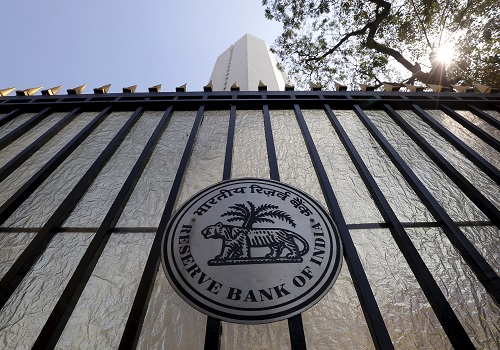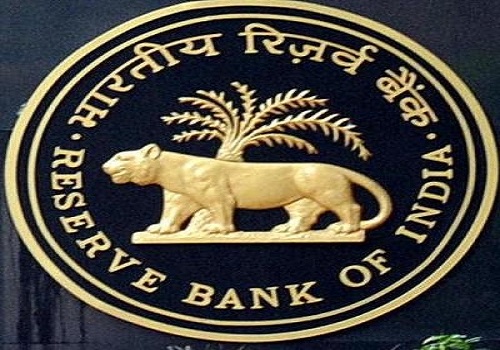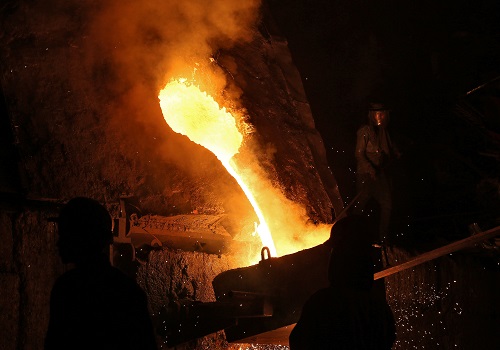Aluminium trading range for the day is 197.7-204.3 - Kedia Advisory

Follow us Now on Telegram ! Get daily 10 - 12 important updates on Business, Finance and Investment. Join our Telegram Channel
Gold
Gold posted a gain of 0.41%, settling at 62574, driven by a slight pullback in the U.S. dollar and Treasury yields. Traders were positioning themselves based on upcoming remarks from Federal Reserve officials to gauge the potential pace of interest rate cuts this year. Two Fed members noted that inflation could continue to decrease amid a strong economy, suggesting the central bank may take its time before deciding on interest rate cuts. Fed Chair Jerome Powell emphasized the need for prudence in deciding when to cut benchmark interest rates, given the current strength of the economy. The CME Fed Watch Tool indicates a 65% chance of a U.S. rate cut in May, as investors eagerly await remarks from at least eight Fed speakers scheduled to speak this week for further insights into the timing of potential rate cuts. Data from the U.S. Labor Department revealed a robust increase of 353,000 jobs in January, nearly double the forecasted 180,000, influencing market sentiment. In India, slow physical gold buying was observed as jewellers awaited a possible import duty cut, and retail consumers hesitated due to higher prices. Conversely, China, a top consumer, experienced strong demand during the festive period. Technically, the market saw fresh buying, with a 1.56% increase in open interest, settling at 14,403 contracts. Gold is currently finding support at 62325, with potential downside testing at 62070. On the upside, resistance is anticipated at 62730, and a move above could lead to testing 62880.
Trading Ideas:
* Gold trading range for the day is 62070-62880.
* Gold regained some ground on a slight pullback in the U.S. dollar and Treasury yields
* Two Fed members mentioned that inflation could continue to fall and the central bank could take its time before lowering interest rates
* Fed Chair Jerome Powell stated that the Fed can be "prudent" in deciding when to cut rates, given the strong economy
Silver
Silver closed with a modest gain of 0.16%, settling at 70594, as the dollar and bond yields retreated from recent highs, countering hawkish remarks from Federal Reserve officials. Traders adjusted their expectations for aggressive rate cuts following comments from Minneapolis Federal Reserve Bank President Neel Kashkari, who highlighted lower risks to the US economy, giving the central bank room to reconsider rate adjustments. This sentiment was echoed by Chicago Fed's Austan Goolsbee, emphasizing the importance of favorable inflation data. The robust economic outlook in the US, supported by strong labor market and Manufacturing PMI data for January, was further reinforced by the outperformance of the Services PMI. Representing two-thirds of the US economy, the Services PMI rose to 53.4, surpassing expectations and the previous reading. The sub-index for new orders indicated a strong order book for 2024, standing at 55.0 against the forecast of 52.8. Geopolitical developments, such as hopes for a ceasefire between Israel and Palestine in Gaza, could exert additional pressure on gold prices. However, Federal Reserve Governor Michelle Bowman cautioned against premature rate cuts, emphasizing the encouraging signs in declining price pressures but warning that premature cuts might delay reaching the 2% inflation target. From a technical perspective, the silver market witnessed fresh buying with a 0.23% increase in open interest, settling at 32334, accompanied by a price increase of 114 rupees. Support for silver is identified at 70355, with a potential test of 70115, while resistance is likely at 70780, and a breakout could lead to testing 70965.
Trading Ideas:
* Silver trading range for the day is 70115-70965.
* Silver recovers as dollar and bond yields slipped from recent highs
* Traders scaled back their bets for aggressive rate cuts following hawkish Fed comments.
* Fed’s Kashkari said that officials have time to study data before cutting rates.
Crude Oil
Crude oil eked out a modest gain of 0.05%, settling at 6084, driven by concerns over escalating tensions in the Middle East, which raised apprehensions about potential disruptions to oil supply from the region. Despite these concerns, oil prices continued to recover from last week's losses, with no immediate disruptions reported. The geopolitical tensions in the Middle East remained a focal point for market participants. However, the market faced headwinds from fading expectations of immediate interest rate cuts by the U.S. Federal Reserve, contributing to a cautious global demand outlook. Persistent concerns about China's economic recovery further weighed on the overall sentiment. Notably, U.S. crude oil exports to Asia saw a significant decline in January, dropping to 1 million barrels per day, the lowest in over two years. High freight rates and competitively-priced Middle Eastern oils contributed to the decline, particularly impacting shipments to China, the world's largest crude importer. On a positive note, the International Energy Agency (IEA) revised its 2024 oil demand growth forecast upward for the third consecutive month, anticipating a rise of 1.24 million barrels per day. However, this remains substantially lower than OPEC's more optimistic projection of 2.25 million bpd. Technically, the market witnessed short covering, with a notable -14.23% drop in open interest, settling at 11,296 contracts. Crude oil is currently finding support at 6028, with potential downside testing at 5971. Resistance is anticipated at 6139, and a move above could lead to testing 6193.
Trading Ideas:
* Crudeoil trading range for the day is 5971-6193.
* Crude oil gains due to concerns about escalating Middle East tensions
* US crude oil exports to Asia have dropped to the lowest level in over two years
* IEA revised its 2024 oil demand growth forecast upward.
Natural Gas
Yesterday, natural gas prices experienced a slight decline of -0.4% to settle at 173.2, driven by several factors. Increased output contributed to a surplus in supply, as gas wells gradually resumed operations following disruptions caused by extreme cold in mid-January. However, the flow of gas to LNG export plants decreased, mainly due to ongoing maintenance issues at Freeport LNG's facility in Texas. Despite the rise in output to 105.4 billion cubic feet per day (bcfd) in February from 102.1 bcfd in January, it remained below the record high of 106.3 bcfd in December. Additionally, meteorologists predict warmer-than-normal temperatures in the Lower 48 states until mid-February, followed by a return to near-normal levels, potentially boosting gas demand. Looking ahead, LSEG forecasts a rise in U.S. gas demand to 124.6 bcfd next week, up from 121.8 bcfd this week, driven by seasonally colder weather. However, the forecast for this week was lower than previously anticipated, reflecting changing demand expectations. Gas flows to major LNG export plants declined to 13.6 bcfd in February, down from 13.9 bcfd in January and December's record high of 14.7 bcfd. From a technical standpoint, the market is witnessing long liquidation, with open interest remaining unchanged at 67,011. Prices dropped by -0.7 rupees, indicating a bearish sentiment. Natural gas is currently finding support at 171, with potential downside targets at 168.8. On the upside, resistance is anticipated at 175.7, with a breakout possibly leading to a test of 178.2.
Trading Ideas:
* Naturalgas trading range for the day is 164.4-178.6.
* Natural gas dropped due to rising output and lower demand forecasts.
* Gas production is increasing as wells return to service after freezing in mid-January.
* LNG feedgas remains low due to an ongoing unit outage at Freeport LNG's export plant in Texas.
Copper
Copper prices experienced a decline of -0.84% yesterday, settling at 715.95, amidst expectations for stronger policy measures from China to bolster markets. China's central bank took steps to inject liquidity into the economy, conducting 100 billion yuan of 14-day reverse repos and reducing the reserve requirement ratio for financial institutions. These measures are anticipated to release approximately 1 trillion yuan of long-term liquidity, aiming to support economic growth. However, nearby demand in China remains subdued as the country approaches the Lunar New Year holiday, leading to muted activity in the copper market. Furthermore, copper inventories in LME-registered warehouses continued to decrease, reaching five-month lows, indicating a tightening supply situation. This slowdown is also reflected in copper inventories monitored by the Shanghai Futures Exchange, which surged 36% this week to their highest level since July. On the production side, copper output in Chile, the world's largest producer of the metal, remained unchanged year-on-year in December at 495,537 metric tons. However, manufacturing production in Chile decreased by 1.8% during the same period, suggesting potential challenges in domestic consumption. Amidst these fundamental dynamics, the technical outlook for the copper market indicates long liquidation. Open interest remained unchanged at 5207, while prices declined by -6.1 rupees. Currently, copper is finding support at 713.2, with a potential downside test of 710.4. On the upside, resistance is anticipated at 720.7, with a breakout possibly leading to a test of 725.4.
Trading Ideas:
* Copper trading range for the day is 714.2-720.2.
* Copper gains due to hopes for more supportive measures from China.
* China's central bank conducted reverse repos and reduced the reserve requirement ratio.
* Copper inventories in LME-registered warehouses are at five-month lows.
Zinc
Zinc prices saw a modest uptick of 0.25% yesterday, settling at 217.55, largely driven by developments in the supply side of the market. The delay in production start at Russia's new Ozernoye mine, attributed to Western sanctions and a plant fire, has tightened near-term supply outlooks. Originally slated for production in 2023, the mine's delayed start until at least the third quarter of 2024, with full capacity not expected until 2025, underscores the challenges facing the zinc market. However, sustained price rallies are contingent upon a significant uptick in zinc demand and a shift away from market concerns over projected surpluses, particularly in the context of zinc's usage in galvanizing steel. Despite these supply disruptions, concerns over zinc supplies have not translated into significant market sentiment shifts, as evidenced by the discount for cash over three-month zinc contracts on the LME remaining largely stable over the past nine months. Surpluses are also apparent in zinc deliveries to LME-registered warehouses, which have surged nearly 200% since November to 199,125 tons, indicating a lack of immediate supply pressure. However, data from the ILZSG showed that the global zinc market deficit widened to 71,600 metric tons in November 2023 from 62,500 tons in October. From a technical standpoint, the market witnessed short covering, with open interest dropping by -0.77% to settle at 4381, while prices increased by 0.55 rupees. Zinc is currently finding support at 216.7, with potential downside testing of 215.7. On the upside, resistance is anticipated at 218.7, with a breakout potentially leading to a test of 219.7.
Trading Ideas:
* Zinc trading range for the day is 215.7-219.7.
* Zinc gains as Russian new zinc mine delays start of concentrate production until at least Q3
* Global zinc supplies for this year are estimated at around 14 million tons
* The global zinc market deficit increased to 71,600 metric tons in November 2023 from a deficit of 62,500 tons in October
Aluminium
Aluminium prices experienced a decline of -1.04% yesterday, settling at 199.6, with mixed factors influencing market sentiment. Efforts by China to stabilize its markets and reduce metal inventory provided some support, although gains were capped by a strong dollar. China's Nonferrous Metals Industry Association (CNIA) reported a 30% decrease in aluminium product exports to the European Union covered by the bloc's carbon border tariff in 2023. This decline follows the EU's implementation of the Carbon Border Adjustment Mechanism (CBAM) to curb imports of more polluting products, aligning with its green transition goals. Despite efforts to stabilize markets, China's official PMI data indicated contraction in factory activity for the fourth consecutive month. However, the Caixin China General Manufacturing PMI unexpectedly held steady at 50.8 in January 2024, beating market forecasts and marking the third consecutive month of growth. Additionally, primary aluminium imports surged globally to 1.54 million metric tons in 2023, falling just short of the record tally accumulated in 2021. However, Japan witnessed a 26% decline in primary aluminium imports to 1.03 million metric tons in 2023, attributed to slow demand in construction and manufacturing industries. From a technical standpoint, the aluminium market is undergoing long liquidation, with open interest remaining unchanged at 3737, while prices decreased by -2.1 rupees. Aluminium is currently finding support at 198.8, with potential downside testing of 197.9. On the upside, resistance is anticipated at 201, with a potential breakout leading to a test of 202.3.
Trading Ideas:
* Aluminium trading range for the day is 197.7-204.3.
* Aluminium gains as efforts by China to stabilise its markets.
* China's export of aluminium covered by EU carbon tax down 30% in 2023
* Japan's imports of primary aluminium fell 26% to 1.03 million metric tons in 2023
Cotton
Cotton witnessed a decline of -0.38%, settling at 57500, influenced by a reduction in world consumption forecasts for the 2023/24 season. Projections indicate a 1.3 million bales decrease in consumption, primarily attributed to reductions in India, Indonesia, Pakistan, Uzbekistan, and Turkey. The higher forecast for ending stocks in 2023/24, driven by elevated beginning stocks and production along with lower consumption, contributed to the downward pressure on prices. The Cotton Association of India (CAI) maintained its estimate for domestic cotton consumption during the 2023-24 season at 311 lakh bales. Pressing estimates for the season were also maintained at 294.10 lakh bales. The CAI's assessment is based on inputs from members and other trade sources. The total cotton supply till the end of the 2023-24 season remains at 345 lakh bales, according to CAI. Brazil's historic high cotton production in the 2022-23 season, driven by expanded cultivation and productivity, led to bloated inventories globally. However, sluggish demand, influenced by unfavorable economic conditions, contributed to reduced cotton prices worldwide. Reports of a decline in pink bollworm infestation in the Indian cotton crop are noted, with a reduction from 30.62% in 2017-18 to 10.80% in 2022-23. Technically, the market is under fresh selling with a 0.91% increase in open interest, settling at 331, accompanied by a price decline of -220 rupees. Support for Cottoncandy is identified at 57400, with a potential test of 57300, while resistance is likely at 57600, and a breakout could lead to testing 57700.
Trading Ideas:
* Cottoncandy trading range for the day is 57300-57700.
* Cotton dropped as World consumption in 2023/24 is forecast 1.3 million bales lower than last month
* World 2023/24 ending stocks are forecast 2.0 million bales higher this month driven by higher beginning stocks.
* World production is 260,000 bales higher with China’s crop up 500,000 bales and Argentina’s production higher as well
* In Rajkot, a major spot market, the price ended at 26747.7 Rupees dropped by -0.27 percent.
Turmeric
Turmeric faced a decline of -1.56%, settling at 15532, driven by profit booking after previous gains supported by reduced supplies in the spot market. Delayed harvesting of the new crop and tighter ending stocks are expected to maintain positive sentiments in the near term. However, the market experiences limitations on the upside as buying activities slow down in anticipation of stock releases ahead of the commencement of new crops. Pressure is also observed due to improved crop conditions resulting from favorable weather. Export dynamics show a decline in turmeric exports during Apr-Nov 2023 by 1.07% at 1,10,745.38 tonnes compared to the same period in 2022. In November 2023, exports dropped by 15.34% compared to October 2023 and by 30.78% compared to November 2022. The slowdown in exports may be attributed to various factors, including festival-related domestic demand and potential stockpiling by traders. Turmeric imports during Apr-Nov 2023 declined by 29.50% at 9,384.42 tonnes compared to the same period in 2022. In November 2023, imports dropped by 48.82% compared to October 2023 and by 12.99% compared to November 2022. In the Nizamabad spot market, a major trading center, turmeric prices ended at 13830.55 Rupees, reflecting a decline of -0.6%. Technically, the market is under fresh selling with a 1.66% drop in open interest, settling at 13435, accompanied by a price decline of -246 rupees. Support for turmeric is identified at 15306, with a potential test of 15078, while resistance is likely at 15856, and a breakout could lead to testing 16178.
Trading Ideas:
* Turmeric trading range for the day is 15078-16178.
* Turmeric dropped on profit booking after prices gained supported by reduced supplies.
* Delayed harvesting of new crop and tighter ending stocks is likely to keep market sentiments up
* Export has been slow down in recent months and expected to increase in wake of series of festivals ahead.
* In Nizamabad, a major spot market, the price ended at 13830.55 Rupees dropped by -0.6 percent.
Jeera
Jeera prices registered a notable increase of 0.8%, settling at 27175, driven by profit booking following a recent drop in prices due to higher production prospects in key cultivating states of Gujarat and Rajasthan. The current rabi season witnessed a four-year high in jeera acreage, with farmers responding to record prices in the previous marketing season, leading to a significant expansion in cultivation areas. In Gujarat, jeera cultivation expanded by 160%, covering 5.60 lakh hectares compared to the previous year's 2.75 lakh hectares, exceeding the normal acreage of 3.5 lakh hectares. Rajasthan also saw a 25% increase, reaching 6.90 lakh hectares compared to 5.50 lakh hectares in the previous year. This surge in cultivation reflects a strong correlation between market prices and acreage. Global demand for Indian jeera declined as buyers preferred other sources like Syria and Turkey due to comparatively higher prices in India. Other major jeera-producing countries, such as China, Egypt, and Syria, also expect higher yields, affecting the global market. Jeera exports during Apr-Nov 2023 dropped by 33.10%, totaling 84,467.16 tonnes, while imports fell by 1,134.63%, amounting to 16,330.89 tonnes during the same period. In November 2023, jeera exports increased by 30.04% compared to October 2023 but declined by 22.89% compared to November 2022. Technically, the market observed fresh buying, with a 4% increase in open interest, settling at 2106 contracts. Jeera is currently finding support at 26840, with potential downside testing at 26510. Resistance is anticipated at 27380, and a move above could lead to testing 27590.
Trading Ideas:
* Jeera trading range for the day is 26510-27590.
* Jeera gained on short covering after prices dropped due to higher production prospects
* In Gujarat, Cumin sowing witnessed very strong growth by nearly 103% with 530,030.00 hectares against sown area of 2022
* Stockists are showing interest in buying on recent downfall in prices triggering short covering.
* In Unjha, a major spot market, the price ended at 32097.9 Rupees gained by 0.12 percent.
Views express by all participants are for information & academic purpose only. Kindly read disclaimer before referring below views. Click Here For Disclaimer












 320-x-100_uti_gold.jpg" alt="Advertisement">
320-x-100_uti_gold.jpg" alt="Advertisement">









